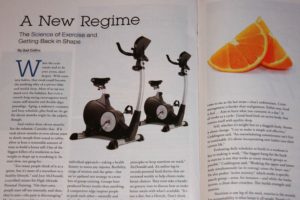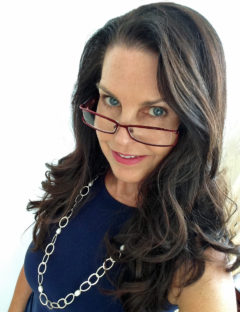![]() January 2011
January 2011
 When the scale creaks and so do your joints, don’t despair. With some new habits, that creak could become the soothing whir of a spinner bike and restful sleep. Most of us eat too much over the holidays, but even a month-long eating extravaganza won’t create stiff muscles and double-digit poundage. Aging, a sedentary existence and busy schedule, plus food on the go for eleven months might be the culprit though.
When the scale creaks and so do your joints, don’t despair. With some new habits, that creak could become the soothing whir of a spinner bike and restful sleep. Most of us eat too much over the holidays, but even a month-long eating extravaganza won’t create stiff muscles and double-digit poundage. Aging, a sedentary existence and busy schedule, plus food on the go for eleven months might be the culprit though.
 And within those eleven months lies the solution. Consider this: If it took eleven months or even eleven years to slowly morph from toned to tubby, give yourself at least a reasonable amount of time to build a better self. One of the biggest killers of a resolution to lose weight or shape up is overdoing it. So start slow, not gung-ho.
And within those eleven months lies the solution. Consider this: If it took eleven months or even eleven years to slowly morph from toned to tubby, give yourself at least a reasonable amount of time to build a better self. One of the biggest killers of a resolution to lose weight or shape up is overdoing it. So start slow, not gung-ho.
“Too many people think of it as a sprint, but it’s more a marathon to a healthy lifestyle,” said Joey McDonald, a certified trainer for High Altitude Personal Training. “On their own, people start off too intensely, and then, they’re sore—the pain is discouraging.” He also mentioned how easy it is to get hurt returning to exercise after a long break or if someone has never trained properly before.
And there is the ho-hum factor. Most people who join a gym in January are bored by March. It can feel lonely and aimless. Working out without sensible goals for individual fitness levels can cause people to give up. Instruction helps people stick with a program to get measurable results.
McDonald said, “We have an individual approach—taking a health history to assess any injuries, flexibility, range of motion and the spine—but we’ve updated our strategy to create lots of group training. Groups have produced better results than anything. A competitive edge inspires people to push each other—mentally and physically—when they work out with their friends or partners.”
But McDonald advocated starting slow. Begin with thirty minutes, two days a week, and then, build the number or days and session lengths over time. Clients should aim for one hour a day, five days a week with a mix of resistance training and cardio workouts.
Nutrition is paramount. In fact, High Altitude Personal Training holds seminars for their clients. “We teach principles to keep nutrition on track,” McDonald said. An online log-in records personal food diaries that are reviewed weekly to help clients make better choices. They even take a hands-on grocery tour to discuss how making better meals with what’s available. “It’s not a diet, but a lifestyle. Don’t think about what you can’t eat, but list what you can eat. It’s about portion control.”
Jesse Coddington of New Roots Personal Training, agreed. He has helped people shed 100 pounds and has helped with other goals. “Nutrition is 70% of overall fitness and health,” said the trophy-winning body builder. “It makes it or breaks it for someone trying to lose weight or build strength.”
Coddington deals often with the morbidly obese and said, “They come to me as the last straw—that’s unfortunate. Crisis management is harder than realignment. Either way, food is fuel… Aim to burn what you consume in a day.” Good food fuels an active body that restores itself with quality sleep.
Still, whether it’s weight loss or a sluggish body, fitness is about change. “I try to make it simple and effective,” Coddington said. “An overwhelming commitment isn’t fun or sustainable. It’s about incorporating new habits into their current life.”
Evaluating daily schedules to build in a workout is key to making it work. “The biggest bang for the buck in exercise is one that works as many muscle groups as possible,” Coddington said. “Working the upper and lower body simultaneously (as in rowing) raises the heart rate.” He also pushes “active recovery” which works a muscle group—arms, for instance—and while the limbs recover, a client does crunches. This builds strength and stamina.
Nutrition is one leg of the stool, exercise is the second, but accountability is what keeps it all steady. People who keep a food journal lose more weight. People who exercise together show up for workouts. People who encourage one another spend more time cheering for each other at weekly weigh-ins.
Lastly, it’s not only about weight. That is one way to measure fitness, but numbers can be misleading. Both trainers prefer to measure in inches or the percentage of lean muscle to body fat. Muscle weighs more than fat, but wears better under clothes. So focus on that pair of jeans you used to fit into and begin.
New fitness habits can empower you to be the healthiest self possible.
NAMLM Gail G. Collins
